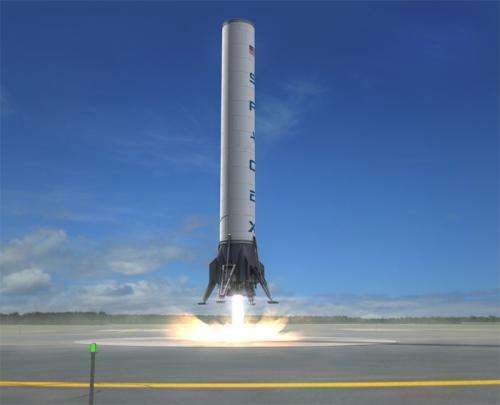SpaceX's 10-story reuseable Grasshopper rocket takes a bigger hop
by Nancy Atkinson,
SpaceX is developing the "Grasshopper" reusable vertical takeoff, vertical landing rocket. Back in September, the 32-meter- (106-ft-) tall Grasshopper made a tiny hop – barely lifting off the pad just to test-fire its engines. But now the Grasshopper has made a second, bigger hop. Over the weekend, Elon Musk quietly tweeted a link to a video, saying, "First flight of 10 story tall Grasshopper rocket using closed loop thrust vector & throttle control." SpaceX hasn't talked much about this rocket, but reportedly the goal with Grasshopper is to eventually create a reusable first stage for its Falcon 9 rocket, which would be able to land safely instead of falling back into the ocean and not being usable again. Here's some info about the Grasshopper from a draft environmental impact assessment put out by the FAA in 2011: The Grasshopper RLV consists of a Falcon 9 Stage 1 tank, a Merlin-1D engine, four steel landing legs, and a steel support structure. Carbon overwrapped pressure vessels (COPVs), which are filled with either nitrogen or helium, are attached to the support structure. The Merlin-1D engine has a maximum thrust of 122,000 pounds. The overall height of the Grasshopper RLV is 106 feet, and the tank height is 85 feet. The propellants used in the Grasshopper RLV include a highly refined kerosene fuel, called RP-1, and liquid oxygen (LOX) as the oxidizer. The reports goes on to say that the Grasshopper test program is to have three phases of test launches, at SpaceX's facility in McGregor, Texas. Phases 1 and 2 would consist of very low test fires with the rocket rising to not more than 73 meters (240 feet) during Phase 1 and 204 meters (670 feet), which is below controlled-airspace. Both Phase 1 and 2 flights would last up to 45 seconds. Phase 3 tests have the goal of increasingly higher altitudes with higher ascent speeds and descent speeds. The altitude test sequence likely would be 366 meters (1,200 feet); 762 meters (2,500 feet); 1,524 meters (5,000 feet); 2,286 meters (7,500 feet); and 3,505 meters (11,500) feet. The maximum test duration would be approximately 160 seconds. If all goes well, the Grasshopper would land back on the launch pad. Here's Grasshopper's first little test hop in September, which SpaceX said went 2 meters (6 feet): Look for more details on this exciting reusable rocket as SpaceX continues its tests of the Grasshopper.



















